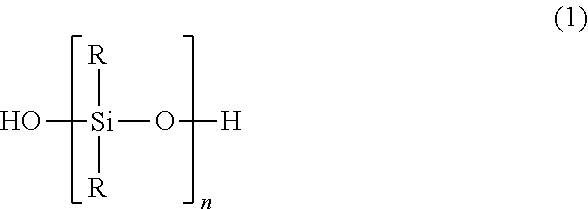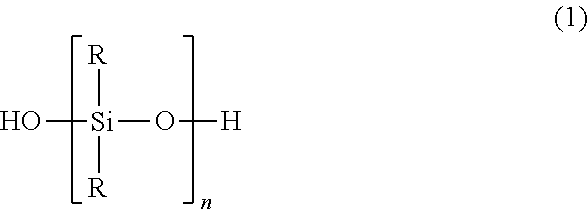Preparing silicone emulsions
a technology of emulsion and silicone, applied in the field of preparation of emulsion, can solve the problems of difficult preparation of emulsions of organopolysiloxanes by emulsion polymerization, complex preparation process, and inability to achieve the optimal emulsion properties such as shear and storage stability, and achieve the effect of reducing the difficulty of emulsion polymerization
- Summary
- Abstract
- Description
- Claims
- Application Information
AI Technical Summary
Benefits of technology
Problems solved by technology
Method used
Image
Examples
example 1
[0070]An emulsifying apparatus (from PC-Laborsystem) is used to combine 5.20% by weight of isotridecyl decaethoxylate, 80% strength in water, commercially available under the trade name Lutensol® TO 108 (from BASF), 4.16% by weight of 4-C10-C13-sec-alkyl-benzene-sulphonic acid, commercially available under the trade name Marlon AS 3 (from Sasol) and 5.20% by weight of demineralized water into an emulsifier mixture to which 49.48% by weight of PDMS 1a (polydimethylsiloxanediol having a terminal OH group content of 0.765% by weight and a viscosity between 70 and 100 mm2 / s) and 1.40% by weight (2.75% by weight based on silicone content) of PDMS 2a (trimethylsilyl-terminated polydimethylsiloxane between 90 and 110 mm2 / s in viscosity) are added a little at a time. Altogether 31.69% by weight of completely ion-free water is then added a little at a time for dilution to obtain a milkily white emulsion. After 20 hours of polymerization at 25° C., aqueous sodium hydroxide solution (25% stren...
example 2
[0071]Example 1 is repeated mutatis mutandis except for the difference that the following starting materials were used: 3.74% by weight of isotridecyl decaethoxylate, 80% strength in water, 2.99% by weight of 4-C10-C13-sec-alkyl-benzenesulphonic acid, 35.66% by weight of PDMS 1a and 3.00% by weight (3.76% by weight based on silicone content) of PDMS 2a. After 20 hours of polymerization at 25° C. and neutralization, a stable emulsion is obtained with an average particle size of 130 nm and a solids content of 45.3% by weight. The polysiloxane precipitated as in Example 1 has a viscosity of 17 900 mm2 / s (25° C.)
example 3
[0072]Example 1 is repeated mutatis mutandis except for the difference that the following starting materials were used: 3.74% by weight of isotridecyl decaethoxylate, 80% strength in water, 2.99% by weight of 4-C10-C13-sec-alkyl-benzenesulphonic acid, 35.66% by weight of PDMS 1b (poldimethylsiloxanediol having a terminal OH group content of 0.418% by weight and a viscosity between 250 and 280 mm2 / s) and 1.50% by weight (4.04% by weight based on silicone content) of PDMS 2a. After 20 hours of polymerization at 25° C. and neutralization, a stable emulsion is obtained with an average particle size of 125 nm.
[0073]The polysiloxane precipitated as in Example 1 has a viscosity of 59 400 mm2 / s (25° C.)
PUM
| Property | Measurement | Unit |
|---|---|---|
| time | aaaaa | aaaaa |
| degree of polymerization | aaaaa | aaaaa |
| temperatures | aaaaa | aaaaa |
Abstract
Description
Claims
Application Information
 Login to View More
Login to View More - R&D
- Intellectual Property
- Life Sciences
- Materials
- Tech Scout
- Unparalleled Data Quality
- Higher Quality Content
- 60% Fewer Hallucinations
Browse by: Latest US Patents, China's latest patents, Technical Efficacy Thesaurus, Application Domain, Technology Topic, Popular Technical Reports.
© 2025 PatSnap. All rights reserved.Legal|Privacy policy|Modern Slavery Act Transparency Statement|Sitemap|About US| Contact US: help@patsnap.com



